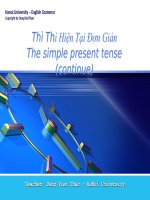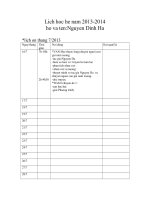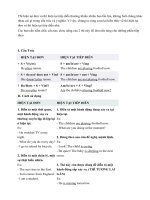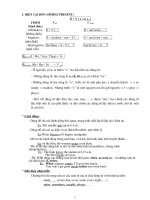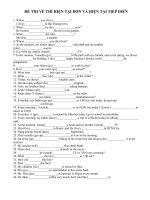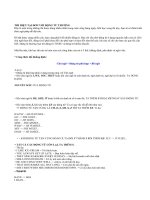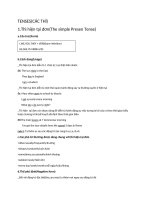Thì hiện tại đơn
Bạn đang xem bản rút gọn của tài liệu. Xem và tải ngay bản đầy đủ của tài liệu tại đây (261.58 KB, 14 trang )
PRESENT SIMPLE
Group 1
English 10 grade
Definition
•
This is the tense which is used the most in life.
•
This tense has only one word
E.g: She goes to school.
Signal
•
Signal word: every (e.g: every morning, every month,
every year, . . . )
•
Adverb of frequency:
-
Use between subject and verb.
-
Eg: I always get up at six o’clock.
He never goes to library.
always 100%
usually 80%
oftens 60%
sometimes 30%
rarely 10%
never 0%
Uses
Use 1: Repeated Actions
•
Express the idea that an action is repeated or usual. The
action can be a habit, a hobby, a daily event, a
scheduled event or something that often happens. It can
also be something a person often forgets or usually does
not do. Express perceptions, feelings, states and
emotions in the present.
•
Eg: I play tennis.
She does not play tennis.
Does he play tennis?
Use 2: Fact or Generalizations
•
The Simple Present can also indicate the speaker believes
that a fact was true before, is true now, and will be true in
the future. It is not important if the speaker is correct
about the fact. It is also used to make generalizations
about people or things. And it is used to describe the rule,
definition.
•
Eg: Cats like milk.
Birds do not like milk.
Do pigs like milk?
Use 3: Scheduled Events in
the Near Future
•
Speakers occasionally use Simple Present to talk about
scheduled events in the near future. This is most commonly
done when talking about public transportation, but it can be
used with other scheduled events as well.
•
Eg: The train leaves tonight at 6 PM.
The bus does not arrive at 12 AM, it arrives at 12 PM.
When do we board the plane?
Use 4: Now
(Non – Continuous Verbs)
•
Speakers sometimes use the Simple Present to express the
idea that an action is happening or is not happening now.
This can only be done with Non-Continuous Verbs and
certain Mixed Verbs.
•
Eg: I am here now.
She is not here now.
Do you have your passport with you?
A) Affirmative form
I/ you/ we/ they + verb (bare-inf)
He/ she/ it + verb –s/es
-
Verb (bare-inf) in first and second person.
-
Verb –s/es in third person. (+es after verb has last word is
o, sh, x, z, ch, s, . . .)
-
Eg: You speak English.
She washes dishes.
B) Negative form
•
Tobe verb
I + am not
You/ we/ they + are not
He/ she/ it + is not
Eg: I’m not in there now.
She isn’t a nurse.
•
Regular verb
-
Use the auxiliary verb don’t/ doesn’t
I/ you/ we/ they + don’t + verb (bare-inf.)
He/ she/ it + doesn’t + verb (bare-inf.)
Eg: They don’t live far away.
He doesn’t like baseball.
C) Interrogative form
•
Tobe
-
Put is/ are at the beginning of the sentence.
Are + You/ we/ they. . .?
Is + He/ she/ it. . .?
Eg: Are you a new student?
Is he a doctor?
•
Regular verb
-
Put do /does at the beginning of the sentence.
Do + You/ we/ they + verb (bare-inf.) ?
Does + He/ she/ it + verb (bare-inf.) ?
Eg: Do they study English well?
Does she live here?
Note:
•
She/ he/ it: add “s” to the verb.
•
Verbs ending in ch, sh, o, x, z, s, e.g. teach, wash, go, . . . Add
“es” to the verb after he/ she/ it.
•
Verbs ending in consonant + y, e.g. cry, study, carry, . . .
Change y -> i and add “es” to the verb after he/ she/ it.
Thank you very much for your
listening.
